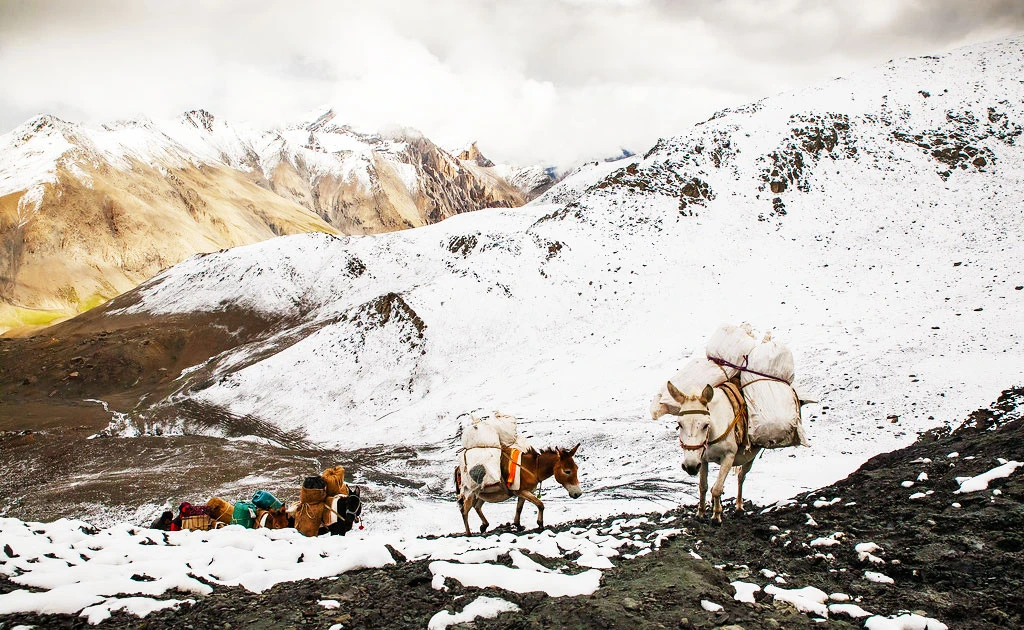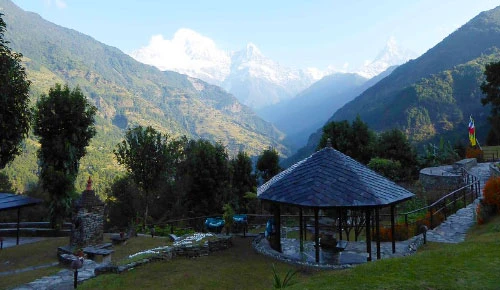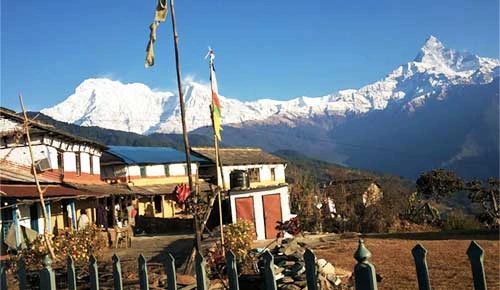Kang La Pass Travel Guide
Kang La Pass is a trekking jewel in Nepal, which is situated far up in the northern end of the Annapurna region. This pass links the remote Nar-Phu Valley and Manang on the high point of the mountain plateau and offers a mixed landscape tour of the remote villages and panoramas of the Himalaya to the adventurer. In this area, one can even hike through peaceful valleys, yak fields, and the rugged paths that most tourists never travel, which is perfect for those who wish solitude and the raw nature of mountains.
In addition to the natural scenery, the Kang La Pass offers a contrasting cultural experience as you pass through Nar village and Phu village, where Tibetan-like culture and ancient monasteries provide insight into life in the Himalayas many centuries ago. The trekking of the pass rewards the trekkers with wide-open views of the Annapurna II, Annapurna III and the Tilicho Peak and a sense of achievement for making it to an altitude.
Whether you are an experienced trekker or a high-altitude explorer seeking an offbeat adventure, Kang La Pass will provide you with a trail of natural beauty, cultural ornaments, and memorable Himalayan landscapes.
When to Visit Kang La Pass: The Best Season, Weather, and Climate
Kang La Pass is trekked best during the spring months of the pre-monsoon season (March-May) and the autumn months (September-November).
Spring (March–May)
Slopes and valleys are teeming with blossoms of rhododendrons and alpine flowers. The climatic conditions are relatively normal, and clear skies are spectacular. One can have excellent views of Annapurna II, Tilicho Peak, and the rest of the Himalaya. During the day, temperatures are moderate, but at higher altitudes, nights are cold.
- Daytime Temperature: 10°C to 18°C
- Nighttime Temperature: 0°C to 5°C
Autumn (September–November)
The air is clean after the monsoons, and visibility is at a maximum, particularly in the mountains. There are great trekking conditions, dry trail with nice temperatures that are suitable for walking long distances. It is also peak season among photographers, as the blue skies prevalent during the time enhance the snow-capped peaks.
- Daytime Temperature: 12°C to 20°C
- Nighttime Temperature: 2°C to 7°C
Winter (December-February)
The winter season is associated with a lot of snow and freezing weather at higher elevations, which makes trekking more difficult. Trails can be steep and greasy or they can be covered by snow and visibility might be reduced. The pass can be only crossed in winter by seasoned trekkers who have adequate winter equipment.
- Daytime Temperature: 0°C to 8°C
- Nighttime Temperature: –10°C to –5°C
Monsoon (June–August)
It is monsoon time with lots of rain, muddy trails, and possible landslides. The mountaintops are usually covered with clouds, and the visibility is decreased as well as the scenery. Trekking at this time is dangerous and not recommended, unless you are a seasoned trekker who is geared to face wet and muddy weather.
- Daytime Temperature: 15°C to 22°C
- Nighttime Temperature: 5°C to 10°C
How to Reach Kang La Pass?
To get to Kang La Pass, you have to get there by a combination of road transportation, hiking, and even by flights, depending on your location. The pass links the NarPhu Valley with Manang, and hence the trip normally starts at Pokhara, which is the primary entry point into the Annapurna region.
Step 1: How to get to Pokhara
Flights: Kathmandu/Pokhara is a 25-30 min. flight using local airline carriers and the air view of the Himalayas is awesome.
Road Travel: Traveling between Kathmandu and Pokhara takes 6 to 8 hours (by tour bus or personal car), and the traveling path will be picturesque mountainous territory.
Step 2: Drive to the Trekking Point.
When trekking at Kang La Pass, trekkers typically start their journey from either Manang or Nar village, depending on their preferred route. The route to a common approach to the Annapurna Circuit and Nar Phu Valleys can be reached starting at Besisahar or Chame which are jeep- or bus-rideable towns restarting in Pokhara.
Step 3: Hiking to Kang La Pass
The actual trek will take 5-6 days to the point-of-views above Manang or Nar, depending on your time frame. The path will take you through Nar and Phu villages, alpine meadows, and yak pastures, as well as several high-altitude camping spots. Itinerary based guided trek is hired by the majority of the trekkers to trek safely through the high-altitude terrain.
Attraction of Kang La Pass Trek
- Mesmerizing mountain views of the Himalayas.
- Cute, antique villages to visit.
- Colorful prayer flags blowing in the wind.
- Mountain valleys filled with yaks.
- Tinkling streams and lakes of a high altitude.
- Conquering the Kang La Pass.
- Trails that are nice and pristine away from the crowd.
- Bellowing glacier torrents in the way.
- Monasteries that stood in bright colors hidden in the mountains.
- Yak trainings are drifting along.
- The mountains are colored by sunrises and sunsets.
- Fresh mountain air, step by step.
- Calm spaces where one could think.
- Sensational contrasting of snow, rocks, and sky.
- Secret vantage points of the photography enthusiasts.
Accommodation & Food on Kang La Pass Trek
Trekking to Kang La Pass takes you to some of the oldest parts of the Annapurna region, and as you walk through this expanse, you'll find a nice blend of warm teahouses, lodges, and simple mountain huts. In villages, such as Nar and Phu, comfortable but simple accommodation is available in warm rooms with clean bedding and either shared or private toilet facilities depending on the lodge.
There is nothing quite as satisfying as a hot, hearty meal after many hours trekking through alpine meadows, yak pastures, and rocky tracks. A meal of Nepali food is provided daily: the traditional Nepali cuisine of dal bhat (rice and lentils), vegetable curries, momos, and noodles, with steaming cups of Nepali tea, coffee, or Tibetan butter tea. The vast majority of the lodges offer local snacks, granola bars, and homemade baked goods to make sure that the trekkers do not starve.
More than just the food, the cheerfulness of the friendly people, their hospitality, and the cozy common areas create a welcoming atmosphere during each journey, making every place feel like home and forming small pockets of pleasant essence against the majestic mountains. The teahouses provide solace even in high camps near the pass, where you can rest, breathe the fresh mountain air, and see the sun casting a golden glow over the mountains; this truly allows for a sense of rest. Dining here is about more than just food; it's about connecting with locals, sharing experiences with other trekkers, and enjoying the surrounding Himalayas.
Things to Do in Kang La Pass Trek
- Trekking: The Kang La Pass trek includes a breathtaking panorama of Annapurna II, Tilicho Peak and the ranges, which go through alpine pastures, yak pastures, and glacier waters. Multi-day trips are available that enable trekkers to traverse various terrains, including mountainous areas, untouched valleys, and secret sightseeing locations.
- Village Exploration: The ancient Nar and Phu villages offer a walk through town experiencing Tibetan-influenced village culture. Stone houses with colored prayer flags and narrow lanes are looking to be explored, whereas locals are friendly, providing information about the traditional life of the Himalayas and yak raising.
- Nature & Photography: Capture the beauty of snow-capped peaks, turquoise lakes, and cascading streams along the trail. Sunrise and sunset views from high camps or ridges are especially magical, making every stop a photo opportunity.
- Cultural Experiences: Visit monasteries, local temples, and yak caravan routes to witness centuries-old traditions still alive today. Sampling local foods like dal bhat, momos, and butter tea adds flavor to both the journey and cultural immersion.
- Relax & Reflect: Pause at quiet corners of the trail to breathe in crisp mountain air, soak in the serenity of untouched landscapes, and enjoy the peaceful rhythm of life high in the Himalayas.
- Adventure & Discovery: For the adventurous, exploring hidden ridges, lesser-known viewpoints, and remote trails adds an element of discovery. Each step toward the Kang La Pass summit brings a sense of accomplishment and reward, as the panoramic vistas of the Himalayas stretch endlessly in every direction.
- Wildlife & Flora: Observe Himalayan birds, mountain goats, and yaks grazing in alpine meadows, and notice the colorful wildflowers and rhododendrons that bloom along the trail in spring.
- Local Interaction: Spend time with friendly villagers, learning about their traditions, crafts, and the local way of life. Participate in simple cultural activities or festivals if your trek timing allows.
Trekking Routes Covering Kang La Pass
Kang La Pass Trek with Thorong La Pass
It is one of the most adventurous Annapurna trekking trails, consisting of a powerful blend of two of the most famous passes, Kang La Pass and Thorong La Pass, joined in one trekking adventure. The trek starts by visiting the remote Nar and Phu valleys and the centuries-old Tibetan traditions are still prevailing there. It goes up to the steep Kang La Pass after that to reveal wild Himalayan terrain and panoramic views of Annapurna and beyond.
This is followed by heading towards another legendary pass, Thorong La Pass, the highest and also the most iconic trekking pass in Nepal. Summiting both these passes in one trek is not only a physical accomplishment but also a once-in-a-lifetime adventure, which is the combination of culture, raw Himalayan beauty, and a sense of adventure in high-altitude trekking.
In case you are interested in participating in this great adventure, Nepal trek adventure is arranging an amazing trip to Kang La Pass Trek with Thorong La Pass that will guide you with expertise, safe planning and an incredible trekking experience throughout.
Nar Phu Valley Trek
The Nar Phu Valley Trek is one of the treasures of culture, obscured deep in the folds of the Annapurna region. It leads you to two very distant villages, Nar and Phu, where time runs slowly like in the traditional days and Tibetan influence is strongly embedded. Traveling and hiking in narrow canyons, old monasteries, and villages comprised of stones will make you feel like you are traveling back in time.
The best part of this trek is the great pass through the Kang La, giving a great panorama of Annapurna II, Gangapurna and Tilicho Peak. It is a journey that combines culture, remoteness and Himalayan scenery, and it is hard to find another similar path.
Tilicho Lake with Kang La Pass Trek
The trek is ideal for those seeking adventure, where natural scenic beauties are joined together with high-altitude experience. The trip will involve visiting the Tilicho Lake, one of the highest lakes in the whole world, which has beautiful blue waters that reflect the mountains covered with snow.
After exploring the sightseeing in this picturesque landscape, the trail takes a more challenging route towards Kang la Pass, the route to which is extremely challenging but the payoff is out of this world. The massive Himalayan panorama, with the taste of the local culture in the villages nearby, makes this trek full of beauty, adventure, and discovery. It is a path for those who need something more than usual trekking routes.
Thorong La Pass Extension Treks
There are extended forms of the Annapurna Circuit that extend to go via Kang La Pass too. These trails are meant to take those trekkers who are willing to evade the busy trails and enjoy the wilderness of the Annapurna region with its raw and untouched beauty.
The addition of the Kang La with Thorong La makes the adventure more challenging and yet enriched with an endless horizon of snow peaks, rocky cliffs, the dawn of the valley, and so on. It is a test of stamina and character, but the feeling of accomplishment when you finish both is something that cannot ever be forgotten. This mix-up trek is the benchmark of the Himalayan expedition for most trekkers.
Conclusion
Kang La Pass is not only a high-altitude crossroad but also an adventure, cultural and an outstanding view corridor of the Annapurna region. Whether you add it to the Thorong La, combine it with Tilicho Lake, or visit it via the secretive Nar Phu Valley, all routes have something special to offer and never forget. The journey will be challenging, and one must be well prepared; however, the rewards come along the way as it offers breathtaking Himalayan panoramas and access to ancient villages. Nepal Trek Adventure allows you to do it, in a safe and comfortable manner, with expert advice every step of the way; it is not just a walk in a trail but rather a trail worth walking in.




